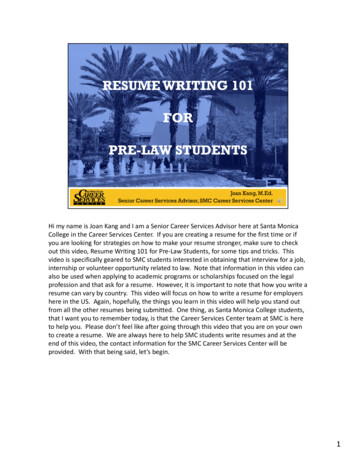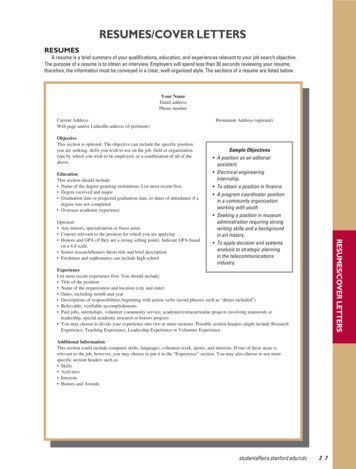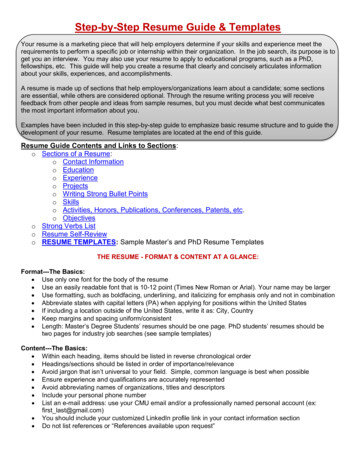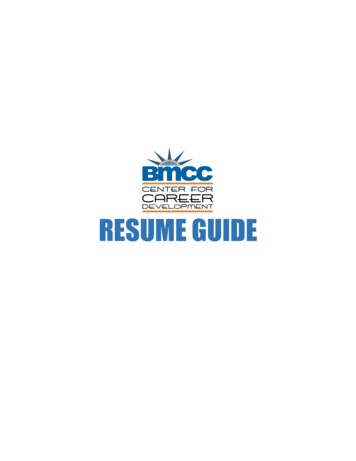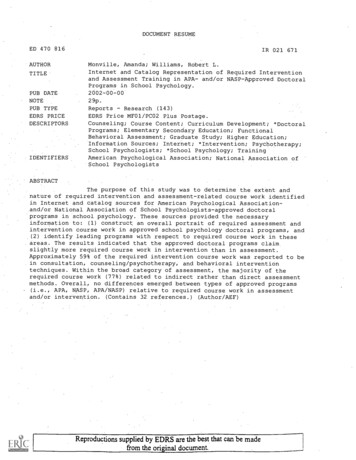
Transcription
DOCUMENT RESUMEED 470 816AUTHORTITLEPUB DATENOTEPUB TYPEEDRS PRICEDESCRIPTORSIDENTIFIERSIR 021 671Monville, Amanda; Williams, Robert L.Internet and Catalog Representation of Required Interventionand Assessment Training in APA- and/or NASP-Approved DoctoralPrograms in School Psychology.2002-00-0029p.ReportsResearch (143)EDRS Price MF01/PCO2 Plus Postage.Counseling; Course Content; Curriculum Development; *DoctoralPrograms; Elementary Secondary Education; FunctionalBehavioral Assessment; Graduate Study; Higher Education;Information Sources; Internet; *Intervention; Psychotherapy;School Psychologists; *School Psychology; TrainingAmerican Psychological Association; National Association ofSchool PsychologistsABSTRACTThe purpose of this study was to determine the extent andnature of required intervention and assessment-related course work identifiedin Internet and catalog sources for American Psychological Associationand/or National Association of School Psychologists-approved doctoralprograms in school psychology. These sources provided the necessaryinformation to: (1) construct an overall portrait of required assessment andintervention course work in approved school psychology doctoral programs, and(2) identify leading programs with respect to required course work in theseareas. The results indicated that the approved doctoral programs claimslightly more required course work in intervention than in assessment.Approximately 59% of the required intervention course work was reported to bein consultation, counseling/psychotherapy, and behavioral interventiontechniques. Within the broad category of assessment, the majority of therequired course work (77%) related to indirect rather than direct assessmentmethods. Overall, no differences emerged between types of approved programs(i.e., APA, NASP, APA/NASP) relative to required course work in assessmentand/or intervention. (Contains 32 references.) (Author/AEF)Reproductions supplied by EDRS are the best that can be madefrom the ori inal document.
Internet and Catalog1Running head: INTERNET AND CATALOG REPRESENTATIONInternet and Catalog Representation of Required Intervention and Assessment Training in APAand/or NASP-Approved Doctoral Programs in School PsychologyAmanda Monville and Robert L. WilliamsThe University of TennesseeU.S. DEPARTMENT OF EDUCATIONPERMISSION TO REPRODUCE ANDDISSEMINATE THIS MATERIAL HASBEEN GRANTED BYOffice.of Educational Research and ImprovementEDU ATIONAL RESOURCES INFORMATIONCENTER (ERIC)This document has been reproduced asreceived from the person or organizationoriginating it.R.L. WilliamsMinor changes have been made toimprove reproduction quality.TO THE EDUCATIONAL RESOURCESINFORMATION CENTER (ERIC)Points of view or opinions stated in thisdocument do not necessarily representofficial OERI position or policy.1BEST COPY AVAILABLE1)6
Internet and Catalog2AbstractThe purpose of this study was to determine the extent and nature of required intervention andassessment-related course work identified in Internet and catalog sources for APA- and/orNASP-approved doctoral programs in school psychology. These sources provided the necessaryinformation to (a) construct an overall portrait of required assessment and intervention coursework in approved school psychology doctoral programs and (b) identify leading programs withrespect to required course work in these areas. The results indicated that the approved doctoralprograms claim slightly more required course work in intervention than in assessment.Approximately 59% of the required intervention course work was reported to be in consultation,counseling/psychotherapy, and behavioral intervention techniques. Within the broad category ofassessment, the majority of the required course work (77%) related to indirect rather than directassessment methods. Overall, no differences emerged between types of approved programs (i.e.,APA, NASP, APA/NASP) relative to required course work in assessment and/or intervention.
Internet and Catalog3Internet and Catalog Representation of Required Intervention and Assessment Training inAPA- and/or NASP-Approved School Psychology Doctoral ProgramsA majority of students considering graduate study use the Internet to acquire informationabout possible graduate programs (Trainor & Dean, 2001). The highest percentage of theseInternet users, according to Trainor and Dean, get their program information directly from schoolweb sites. Students who enter the top-ranking programs are the most likely to use the Internet asa primary source of information about prospective programs. In fact, the Internet users considerthe national ranking of a school the most important reason for selecting a program. Studentsregard program curriculum as one of the more important areas of information to retrieve fromschool web sites. Overall, 92% of students rate the information retrieved from school web sitesas ranging from somewhat helpful to very helpful in selecting a graduate program.The findings of the Trainor and Dean (2001) study have implications for how prospectivestudents can efficiently acquire information about doctoral programs in school psychology.Ideally, such students would begin their search for a program by developing an overview of thetype of doctoral training available in school psychology. Having developed this broadperspective, prospective students then would identify the most reputable programs. Nationalaccreditation would serve as the most public index of a program's standing within the discipline.After identifying the highly regarded programs, students would need to seek specific informationregarding training opportunities in those programs. For example, one important issue toinvestigate would be the curriculum in the prospective programs.The most efficient way for students to get information regarding doctoral programs inschool psychology is through program web sites and related published information, such asprogram brochures and college catalogs (Trainor & Dean, 2001). The APA Guidelines and4
Internet and Catalog4Principles for Accreditation of Programs in Professional Psychology, specifically Domain G:Public Disclosure, requires that each program be "described accurately and completely indocuments that are available to current students, prospective students, and other publics . . in a.manner that allows applicants to make informed decisions about entering the program"(Committee on Accreditation, 2000, p. 11). Program curriculum is one of several areas that mustbe accurately represented in the public documents.Because a variety of legislative acts and published documents in school psychology makeassessment and intervention pivotal issues in the field, program web sites need to postinformation regarding assessment and intervention courses in the program curriculum. Theimportance of these areas in the curriculum is underscored by several reports regarding timeexpenditure of school psychologists (Smith & Mealy, 1988; Reschly, 1998; Reschly & Wilson,1995). These reports indicate that assessment and intervention represent the two greatest timeinvestments of school psychologists. Although doctoral-trained school psychologists do notalways provide front-line services in the schools, Reschly and Wilson (1997) reported minimaldifferences in masters, specialist, and doctoral-level practices. Thus, because assessment andintervention are the primary services offered by school psychologists, with doctoral-trainedschool psychologist often rendering those services, an important issue in evaluating doctoralprograms in school psychology would be to determine the nature and extent of their course workin the assessment and intervention areas.Much of the emphasis on assessment and intervention within school psychology comesfrom federal statutes. In 1975, the Education of all Handicapped Children Act (P.L. 94-142)(amended in 1990 as the Individuals With Disabilities Education Act, or IDEA) mandated that allchildren have the right to a Free and Appropriate Public Education (FAPE). Moreover, Public5
Internet and Catalog5Law 94-142 (P.L. 94-142) required that FAPE be provided in the Least Restrictive Environment(LRE). This legislation required that children referred for special education receivecomprehensive individual assessments to determine eligibility for such services.The IDEA linkage between assessment and intervention requires the school psychologistto engage in "precisely the types of authentic, intervention-based assessment that the field haslong advocated "(Telzrow, 1999, p. 20). The literature is replete with criticisms regarding theinefficiency of traditional psychometric assessment employed for classification and eligibilitypurposes (Cheramie & Sutter, 1993; Cole, 1996; Eckert et al., 1997; Haney & Evans, 1999;Kramer & Epps, 1991; Rosenfield & Reynolds, 1990; Ysseldyke et al., 1984). Ysseldyke et al.(1984) underscored in School Psychology: A Blueprint for Training and Practice that the goal ofschool psychology should be to "escape its entrapment in simple psychometrics and .be givenopportunities to offer the schools the broader and more thoroughly helpful aspects ofpsychology" (p. 12).The 1997 IDEA regulations require school psychologists to engage in more nontraditionalforms of assessment that provide "detailed information necessary for planning effectiveintervention, such as curriculum-based measurement, systematic direct observation, criterion-referenced tests, and authentic assessment" (Bradley-Johnson et al., 1995, p. 192). Despite theneed for nontraditional assessment, research indicates that "many school psychologists may notbe prepared to take advantage of such opportunities due to lack of appropriate training andsupervision" (Haney & Evans, 1999, p. 301). Wilson and Reschly (1996) reported that schoolpsychologists most often use indirect assessment instruments, with a strong relationship betweenthis practice and their graduate training. For the field of school psychology to deliver on thepractices mandated in the IDEA '97 amendments, graduate training programs in school6
Internet and Catalog6psychology must prepare their students in such areas as behavioral intervention and directmethods of assessment. However, our review of the literature revealed no study evaluating theextent to which school psychology graduate programs provide such training.Consequently, the primary purpose of the current study was to determine the extent andnature of required intervention- and assessment-related course work described in the publicdocuments of approved doctoral programs in school psychology. Specifically, the study wasdesigned to answer the following questions: First, what is the nature and extent of requiredassessment and intervention course work in approved doctoral-level school psychology training?Second, to what extent does approved doctoral training in school psychology require the kind ofassessment and intervention training recommended in IDEA '97? Third, what doctoral programsin school psychology best exemplify assessment and intervention course requirements consistentwith IDEA '97 directives?MethodSamplePrior to the collection of curricular data, we obtained a list of approved programs fromthe most current edition of the Directory of School Psychology Graduate Programs (Thomas,1998). This list was cross-referenced with the list of NASP-approved graduate programs inschool psychology included in the May 2000 issue of the Communique (Prus & Rood) and thelist of APA-approved graduate programs provided in the December 1999 issue of AmericanPsychologist (American Psychological Association). A total of 62 school psychology programsmet the criteria for inclusion in the study. Nine programs were strictly APA-approved, 11programs (counting two programs at Hofstra) were strictly NASP-approved, and 42 programsheld both APA- and NASP-approval. Because Hofstra University has two NASP-approved7
Internet and Catalog7program tracks (one leading to a Ph.D. and the other to a Psy.D.) with somewhat differentcurriculum requirements, they were analyzed as separate programs. On the other hand, New YorkUniversity (APA- and NASP-approved) could not be included because of insufficientinformation regarding required course work. Thus, we analyzed required assessment andintervention courses for a total of 61 programs.ProceduresInternet web sites and catalog sources provided listings of required courses anddescriptions of those courses. The following steps were taken to access each program's web site.First, the list of school psychology graduate programs compiled by and located on the Universityof California, Berkeley's school psychology web site was accessed (University of California,Berkeley, 1999). This list provided a direct link to most school psychology programs' homepages. Second, each program's home page was compared to the web address provided for thatprogram in the Directory of School Psychology Graduate Programs (Thomas, 1998). Third, ifthe two addresses proved inconsistent, both were accessed to determine the most current site.Fourth, program web sites not accessible through University of California, Berkeley's list or theDirectory of School Psychology Graduate Programs were located through a search of therespective universities' home pages. This composite process produced access to every program'sweb site.Upon accessing each program's home page, we took the following steps to collect thecurriculum information relevant to the current study: (a) located a list of the required courses forearning a doctorate in school psychology; (b) obtained a complete list of course descriptions fromthe graduate course catalog available through the university's home page; (c) if necessary,requested a hard copy of the catalog via an e-mail message to an appropriate official in the
Internet and Catalog8graduate admissions office; and (d) if the previous steps did not produce the relevant curriculuminformation, transmitted an e-mail message to the school psychology program director requestinga listing of required courses and descriptions of those courses. Collection of course listings anddescriptions occurred in July of 2000. For programs that admitted only students with a mastersinto their doctoral programs, the masters' courses also were included in the data analysis. Thus,the findings represent assessment and intervention requirements beyond the bachelor's degree.Strategies for Answering Research QuestionsThe relative emphasis given to assessment and intervention in the required course workof school psychology doctoral programs was determined by first identifying required courses thatincluded assessment and/or intervention in their titles or descriptions and then classifying thedescriptions as primarily assessment, primarily intervention, or a combination of the two. Acourse was classified as "primarily" assessment- or intervention-related if the course descriptiongave more emphasis to one domain than the other. If a course description reflected similaremphasis on assessment and intervention, the course was classified as assessment/intervention tosignify combined training in the two areas. If a course title and description appeared somewhatdifferent, the course description was used as the primary source for category determination.Required semester hours were calculated separately for each intervention and assessmentcategory in each program and then contrasted with the combined total across those categories.Totals and percentages of required credit hours in intervention and assessment courses were thencombined across programs to provide an overall picture of the emphasis on intervention andassessment in school psychology doctoral training.Required assessment and intervention courses also were divided into subcategories. Theassessment courses first were subdivided as direct assessment, indirect assessment, or
Internet and Catalog9combinations of indirect and direct assessment. The indirect assessment courses (typicallypsychometric in nature) were further subdivided to reflect more specific assessment targets:intelligence; personality, behavior, and/or emotional; academic; neuropsychological; multipleareas; multicultural; and unspecified. The intervention subcategories included consultation,behavioral, cognitive-behavioral, psychotherapy/counseling, academic, family, multicultural,multiple, psychodynamic/psychoanalytic, and unspecified approaches. A separate major categorywas created for courses that combined assessment and intervention. School Psychology: ABlueprint for Training and Practice II (Ysseldyke et al., 1997) provided the framework for thedevelopment of the assessment and intervention categories.Unless otherwise designated, no course was classified in more than one category. Whencourse themes potentially matched multiple categories, the predominant theme determined theclassification of the course. The total credit hours required in each subcategory across all schoolpsychology doctoral programs were then converted into percentages of total hours required inboth assessment and intervention to determine the relative emphasis placed on the subcategoriesof intervention and assessment. In addition, the percentage of programs requiring course work ineach subcategory and the average number of hours they required in that category were computed.To further delineate the types of assessment and intervention course work required acrossapproved doctoral programs, we contrasted program requirements across accrediting/approvingorganizations: NASP, APA, or NASP/APA.The question of what programs best reflected the assessment and intervention mandatesof IDEA '97 was addressed by calculating course hours in the following areas: direct assessment,direct/indirect assessment, behavioral intervention, cognitive-behavioral intervention, academicintervention, early childhood intervention, family intervention, multicultural intervention, and10
Internet and Catalog10assessment/intervention. Early childhood, family, and multicultural intervention were included inthis analysis because they were highlighted in IDEA '97 as populations needing greater services.For example, Part C of IDEA '97 placed considerable emphasis on providing "early interventionservices to infants and toddlers with disabilities and infants and toddlers who would be at risk ofhaving substantial developmental delays if early intervention services were not provided them"(Individuals with Disabilities Education Act of 1997, p. 126). Credit hours were added across thedesignated categories to identify programs best exemplifying course work requirementsconsistent with IDEA '97 recommendations.Reliability of Data ClassificationTo aid in classifying courses and establishing the reliability of the results, we developeddefinitions of the previously designated assessment and intervention categories/subcategories.Definitions were formulated prior to data collection and modified as the curricular analysisprogressed. Detailed descriptions of these definitions are provided in Monville's dissertation(2001) and can be obtained upon request. In addition to the senior author, a second rater (adoctoral student in school psychology) independently classified the course work for a randomsample of 25% of the programs, using the definitions for the intervention and assessmentsubcategories. Interrater agreement was calculated by dividing the total number of credit hoursagreed upon by the total number of credit hours agreed upon plus the number of credit hoursdisagreed upon and then multiplying by 100. Average interrater agreement was 93% for thenumber of credit hours in the broad categories of assessment and intervention and 81% forsubcategories of intervention and/or assessment.ResultsThe results of this study are presented first for the composite programs and then for11
Internet and Catalog11programs exemplifying the recommendations of IDEA '97. The d
NASP-approved doctoral programs in school psychology. These sources provided the necessary information to (a) construct an overall portrait of required assessment and intervention course work in approved school psychology doctoral programs and (b) identify leading programs





